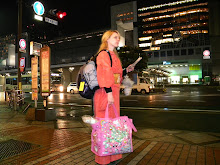My strange behavior began when I first arrived in Korea, months before acquiring the cat hat, following the suit of one of my beloved cats back home in America. She is a dainty little golden-red princess of a cat. Generally docile and amiable, her sweetness dissolves when something threatens her wellbeing – such as a vacuum cleaner or bubbles – and overcome by the threat, her mouth draws back into a feline grimace as she emits a prissy little hiss in protest. That has become me – also dainty, generally sweet tempered, but sometimes pushed too far by things that are beyond my comprehension, and probably that to the rest of Korea seem as harmless as soap bubbles or vacuum cleaners.
Crafted of white velour, and including the features of pointed ears and a red, heart-shaped nose, my kitten hat is something that only a child under the age of five would wear in the Western world; however, certain gender and age-appropriate rules that are inherent in Western society don’t seem to exist in Korea. While it’s true that small children here wear animal hats, this is a more common fashion item among the adults. On a fairly regular basis, I’ll watch a Korean man strolling down the street, with the cool swagger that only college guys in their 20s seem to possess, and also with a grinning polar bear perched atop his head, the fuzzy pink pom poms dangling loosely beneath his chin.
At times, the kitten hat provides me partial anonymity, especially if I comb back my bangs and tuck my blonde ponytail into the back of my coat. People need to actually look at my face to determine that I’m a foreigner, and since commuters don’t always watch the faces of those around them, I’m given a brief respite from the continual stares and my continual status as different. That’s the worst thing about being a foreigner – the thing that grates after months: I’m always treated as different. The majority of the time I’m treated with extra consideration, which is nice, but means a barrier of politeness has been erected between me and the other person. On other, somewhat rare occasions, I’m treated with rudeness. Never am I treated as just an ordinary person. As an artist and as someone who grew up in a small town where conformity was rigidly demanded, I’ve always quietly rebelled against being the same as everyone else. Now that I’m at a place where I so clearly stand out, I just want to blend in.

Perhaps in part because of this desire to belong, I, myself, have begun to adopt Korean viewpoints in some unexpected ways. Praise, a Korean American office mate, and I were recently riding to Sillim, a district in southern Seoul.
“Do you know,” said Praise, using a tone of voice that is generally reserved for conspiratorial gossip, “that Sillim is full of white people? I saw three white people just last night.”
“Really?” I responded with surprise and genuine concern at such a large number of whites overtaking a city of 10 million.
“Hey!” I said, as a second realization suddenly struck me, “I’m white. And you ran into me in Sillim yesterday.”



No comments:
Post a Comment